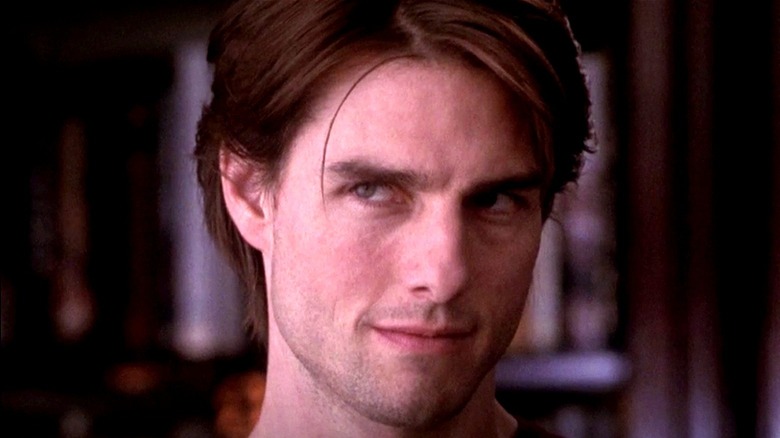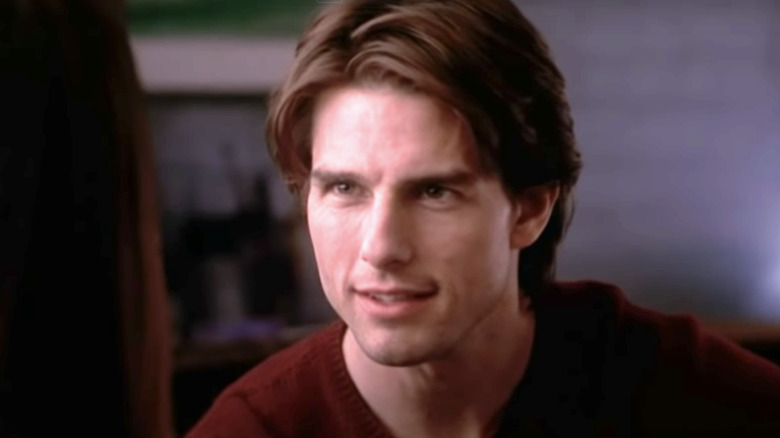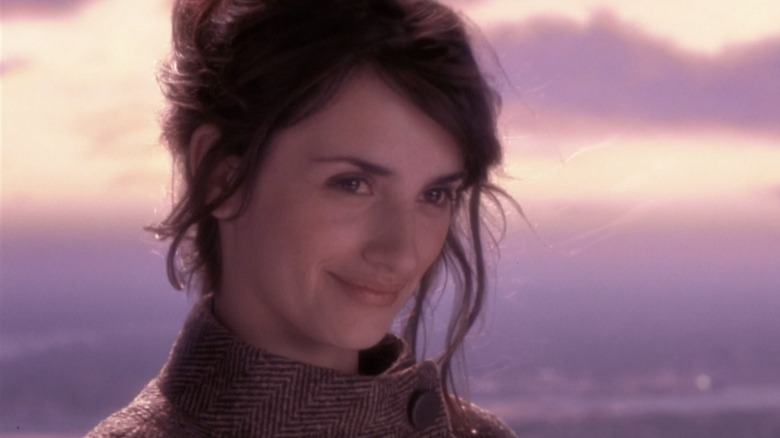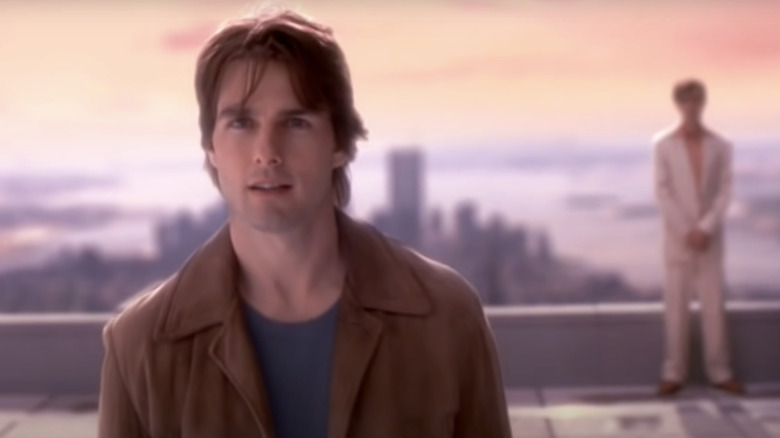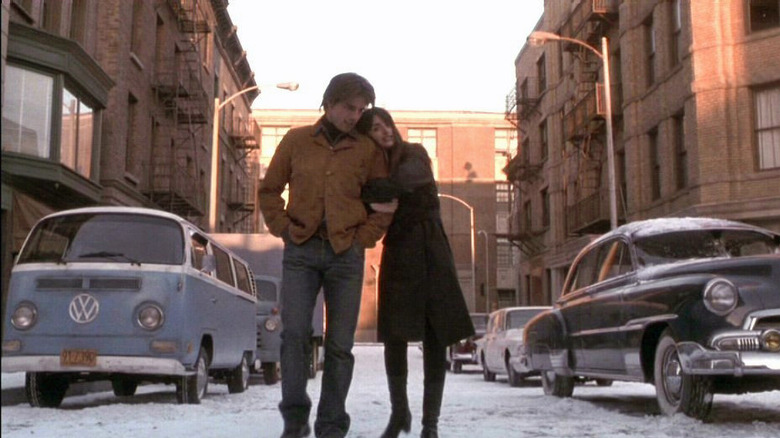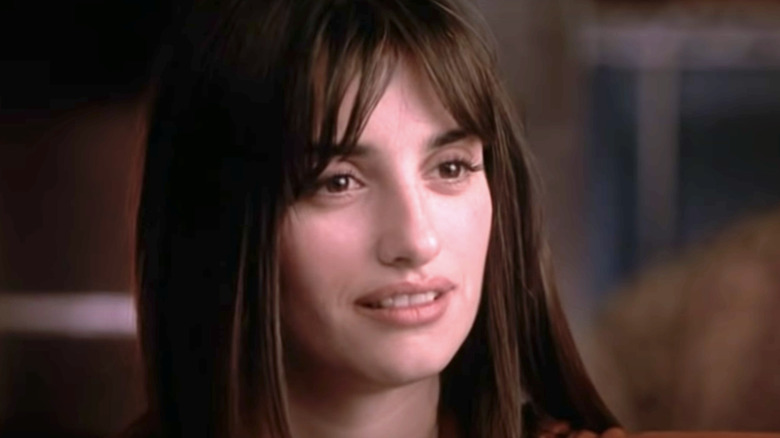The Ending Of Vanilla Sky Explained
"Vanilla Sky" is a 2001 film that blends elements of surreal settings, lucid dreaming, and a subconscious run amok. Starring Tom Cruise, Cameron Diaz, Jason Lee, Kurt Russell, and Penélope Cruz, "Vanilla Sky" was originally lambasted by critics, but it has earned somewhat of a cult status as of late, and the movie holds a 72% audience score on Rotten Tomatoes (against a 42% critic score). Despite that, the movie was a financial success, and it made around $202 million globally with a $70 million budget (via The Numbers).
The protagonist of "Vanilla Sky" is David Aames (Cruise), a wealthy socialite who has inherited a large publishing company. A free-spirited womanizer, Aames is introduced to Sofia Serrano (Cruz), and they both fall in love over a single night. As expected, this does not sit well with Aames' current girlfriend, Julie Gianni (Diaz), and she wrecks a car with both of them in it, resulting in her death and Aames' disfigurement. This part of the film is far more important to the story than it may appear, and a good chunk of the following movie is spent on a shifting plot that involves love and fate, which eventually turns into a nightmarish realm of confusion.
Here is the ending of "Vanilla Sky," explained.
David Aames' mask is a comment on his personality
One of the most important things to remember about this film is that almost the entirety of "Vanilla Sky" is set inside of David Aames' lucid dream. Everything after the car crash is a figment of Aames' imagination, and he has been put into cryogenic stasis until the point in which medicine can repair his mangled face. Throughout the movie, bits of his subconscious pierce this surreal reality, in moments when Sofia and Julie trade places or Aames sees his face as it actually is, and not the dream version of it.
The mask, both literal and figurative, that shows up throughout the film represents an aspect of Aames' psychology and thought process, mainly because a life of luxury has left the character hollow and hedonistic, and few people know the real Aames. The only person that is able to pierce this "mask" is the idealized and fictional version of Sofia, who is created by Aames' subconscious. As the movie progresses, the mask begins to crack and crumble, mirroring the slow dismantling of the visage Aames creates in his head.
Aames must ponder the nature of what is real and important
As the reality of what's going on becomes clearer for Aames, he heads to the top of a skyscraper to make his very important decision at the end of "Vanilla Sky." Led there by a technical support avatar played by Noah Taylor, Aames is given the option between staying inside this reset dream, or waking up and facing the world anew by jumping off the side of the building.
As Aames mulls over this choice, Kurt Russell's court psychologist character Dr. Curtis McCabe appears and grapples with the fact that he is a figment of somebody's imagination. This could be considered a commentary on what constitutes reality, because McCabe clearly thinks that he's real until presented with conflicting information and memories. One might also wonder if the experiences Aames goes through in this lucid dream still have merit despite the fact that no one in there is real. It's really up to him to learn as much or as little from the experience.
Ultimately, Aames is a better and more well-rounded person because of his tenure in this dreamscape, and this mental fortitude aids in his decision to go back to the real world. When he first decides to enter cryogenesis, Aames is unable to deal with the world, his relationships, and his disfigured face, but his time spent with Sofia could be considered one of the best moments in Aames' life, even though none of it is real.
Aames choses to leap from the skyscraper to leave the illusion
Ironically enough, the fact that Aames must jump off the side of the building to wake up from his lucid dream is his idea before being put into stasis, mainly because he is terrified of heights. In this manner, he wants to make absolutely sure he is ready and willing to wake up from his dreaming reality to the difficult, yet real, life he has outside of it.
By confronting a potent personal phobia, Aames must show himself that he has grown and is capable of dealing with adversity in all forms. He eventually chooses to leave the dream by leaping, but beforehand, he is greeted by Sofia, who says they may meet again when they are both cats, which is a reference to an earlier part of the film.
The movie's final scene is a shot of Aames waking up and being welcomed to a new world by someone saying "open your eyes," which also happens to be the same line the movie starts with. While both the audience and Aames are hearing this line a second time, it's a completely new experience featuring a changed protagonist.
Music and pop culture play a huge part in Vanilla Sky
Throughout "Vanilla Sky," there are several iconic scenes and musical choices that carry far more weight then one might realize on the first viewing. The first song used in the film is Radiohead's haunting "Everything in its Right Place," which shows just how painfully constructed Aames' waking and dream lives are. His living world consists of womanizing and spending money, while his dreaming world is generally made of the kind of love people hope and, ahem, dream of.
The image of Bob Dylan's album cover for "The Freewheelin Bob Dylan" is also displayed prominently in Aames' apartment, and later unconsciously recreated by Aames and Sofia as they walk down a New York street. Among other decorations in Aames' apartment are two posters of prominent French films, with the translated titles being "Breathless" and "Jules and Jim." Both of these deal with a tragic main character who causes untold suffering to those around them because of their need to be free, much like the protagonist of "Vanilla Sky."
Perhaps one of the most effective uses of music in the movie is during the scenes when Aames' faux-reality is becoming increasingly unstable, and he is shown running and yelling while "Good Vibrations" by The Beach Boys plays — a particular moment the director, Cameron Crowe, is fond of (via Vulture). One of the last songs to play is by Spiritualized, named "Ladies and Gentlemen We Are Floating In Space," an airy and melancholic song that talks about not only growing stronger, but also asking for the pain to be taken away. This song is played during the ending explanation of Aames' life after he is placed in cryostasis.
There have been many different interpretations of the ending
Considering the overall surreal nature of "Vanilla Sky," it makes sense that people have varying opinions on the general nature of the film and its themes, even after watching it several decades later. While writing for Video Librarian, Sergio Lopez said of the film, "The film's true emotional register is instead of fear, dread, and paranoia, portrayed most powerfully through association and allusion rather than through overt displays — appropriate for a modern society where human connection is mediated through a screen, but darker feelings of unease are both omnipresent and often unnamed."
Even the director himself has told Vulture that there are multiple interpretations of the ending of "Vanilla Sky," and they are all valid. Some of these interpretations, as shared by the website The Uncool, include the idea that Tech Support is telling the truth and that 150 years have passed, the entire film is a dream, the events after the crash are the result of a coma, the entire move is actually a book written by Jason Lee's character, or the entire movie is a drug-induced fever dream brought on by the facial reconstruction.
The director then added, "Sometimes I watch it and I have a completely different take on what the story is, where the splice comes, and what it's all about. Over time, to me the keyhole character, where you can just find a different perspective on the whole thing, is Jason Lee's Brian Shelby. If I stay with Jason Lee in the Rubik's Cube of 'Vanilla Sky,' I always go to the best places." Ultimately, "Vanilla Sky" continues to evoke a great deal of emotion and thought when it comes to the nature of existence and what is real.
